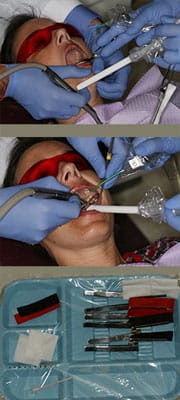
How to Utilize a Dental Assistant to Equilibrate the Dentition
Equilibration or reshaping of teeth is one of the procedures taught at the Dawson Academy. The equilibration process begins with step 7 in the 10 Step 3D Treatment planning Checklist (Provide Equal Intensity Stops). The goal of equilibration is to reshape both posterior and anterior teeth until equal intensity contacts are achieved in centric relation. Like all other procedures, the dental assistants (DA) role is vital to the success of the equilibration process.
Equilibrating the Dentition with the Dental Assistant: The Process
This process is meticulous but requires the efforts of both the Dentist and the Dental Assistant to work together in a smooth, structured and predictable fashion. To effectively utilize the dental assistant role, the following simple steps may be recommended:

- Have your DA hold the cotton gauze + high-speed suction in the non-dominant hand.
- In the other hand (dominant), have your DA hold the air water syringe + articulating paper holder.
- As you begin, the DA must keep all surfaces of the teeth moist free by using the cotton gauze and the air water syringe.
- During manipulation into C.R., as the patient closes, the DA must have the articulating paper in position to mark the first point of contact while holding your mouth mirror.
- After marking is complete, the mouth mirror is returned to the dentist for further equilibration.
- Throughout the process, the surfaces of the teeth are kept dry to accurately prevent the articulating paper markings from smudging and distorting.
- This effective method continues until the goal of equilibration is achieved.
- The dentist must continue to verbally guide the assistant to the side of the mouth that is being treated as this will keep the flow of communication clear.
- Throughout the equilibration process, adequate suction of saliva must be maintained to aid in moisture control.
Equilibrating the dentition can never be done accurately without the help of the Dental Assistant. A well-trained Dental Assistant will understand the goals in achieving a perfected occlusion. By implementing these steps, you can utilize your Dental Assistant’s role more efficiently. Working together in this manner will ensure a predictable outcome, save valuable time, and most importantly instill trust and confidence in your patient.








Leave a Reply
Want to join the discussion?Feel free to contribute!